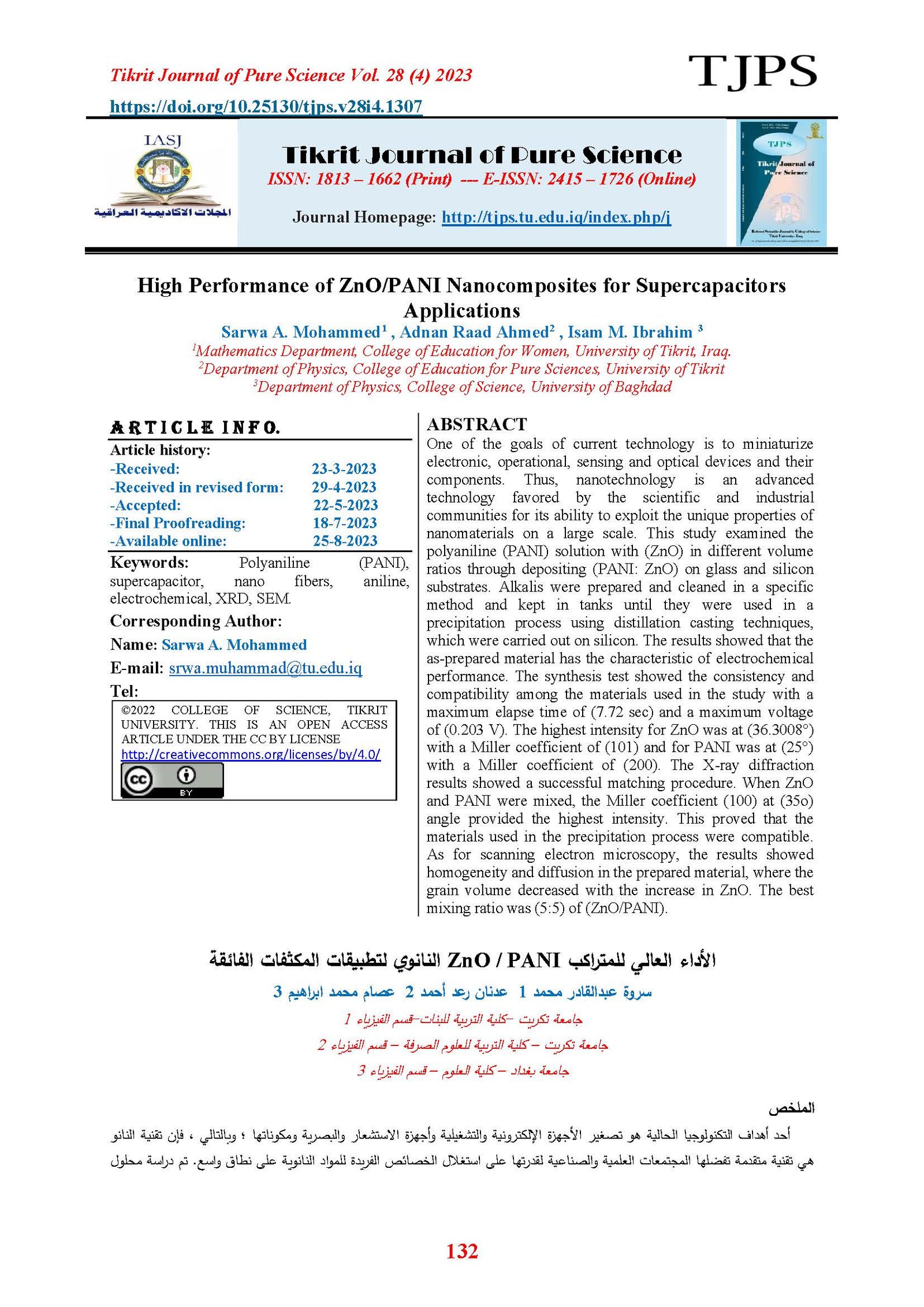High Performance of ZnO/PANI Nanocomposites for Supercapacitors Applications
Main Article Content
Abstract
One of the goals of current technology is to miniaturize electronic, operational, sensing and optical devices and their components. Thus, nanotechnology is an advanced technology favored by the scientific and industrial communities for its ability to exploit the unique properties of nanomaterials on a large scale. This study examined the polyaniline (PANI) solution with (ZnO) in different volume ratios through depositing (PANI: ZnO) on glass and silicon substrates. Alkalis were prepared and cleaned in a specific method and kept in tanks until they were used in a precipitation process using distillation casting techniques, which were carried out on silicon. The results showed that the as-prepared material has the characteristic of electrochemical performance. The synthesis test showed the consistency and compatibility among the materials used in the study with a maximum elapse time of (7.72 sec) and a maximum voltage of (0.203 V). The highest intensity for ZnO was at (36.3008°) with a Miller coefficient of (101) and for PANI was at (25°) with a Miller coefficient of (200). The X-ray diffraction results showed a successful matching procedure. When ZnO and PANI were mixed, the Miller coefficient (100) at (35o) angle provided the highest intensity. This proved that the materials used in the precipitation process were compatible. As for scanning electron microscopy, the results showed homogeneity and diffusion in the prepared material, where the grain volume decreased with the increase in ZnO. The best mixing ratio was (5:5) of (ZnO/PANI).
Article Details

This work is licensed under a Creative Commons Attribution 4.0 International License.
Tikrit Journal of Pure Science is licensed under the Creative Commons Attribution 4.0 International License, which allows users to copy, create extracts, abstracts, and new works from the article, alter and revise the article, and make commercial use of the article (including reuse and/or resale of the article by commercial entities), provided the user gives appropriate credit (with a link to the formal publication through the relevant DOI), provides a link to the license, indicates if changes were made, and the licensor is not represented as endorsing the use made of the work. The authors hold the copyright for their published work on the Tikrit J. Pure Sci. website, while Tikrit J. Pure Sci. is responsible for appreciate citation of their work, which is released under CC-BY-4.0, enabling the unrestricted use, distribution, and reproduction of an article in any medium, provided that the original work is properly cited.
References
1. Wen-Dong Wang, Xiao-Qiang Lin, Hai-Bo Zhao, Qiu-Feng Lü,Nitrogen-doped graphene prepared by pyrolysis of grapheneoxide/polyaniline composites as supercapacitor electrodesJournal of Analytical and Applied Pyrolysis (2016(JAAP-3705; No. of Pages 10. 2. S. Najib , F. Bakan,N. Abdullayeva, R. Bahariqushchi, S. Kasap, G. Franzò, M. SANKIR, N. Demirci Sankir, S. Mirabella and E. Erdem, NanoscaleTailoring morphology to control defect structures in ZnO electrodes for highperformancesuper capacitor devices,Article in Nanoscale,June (2020),DOI: 10.1039/D0NR03921G.
3. E. Mitchell a, J. Candler , Felipe De Souza , R.K. Gupta , Bipin Kumar Gupta b,L.F. Dong,High performance supercapacitor based on multilayer of polyaniline and graphene oxide,Synthetic Metals 199 (2015) 214–218. 4. Peng C, Zhang SW, Jewell D, Chen GZ Ultrathin porous NiMnO3 nanosheets on carbon cloth for use as supercapacitor electrode (2008) ,Prog Nat Sci 18:777 5. Zhu.y, Murali.S, . Stoller.D, Velamakanni.A , Piner and R. S. Ruoff, “Microwave Assisted Exfoliation and Reduction of Graphite Oxide for Ultracapacitors,” Carbon, Vol. 48, No. 7,( 2010), pp. 2118-2122. http://dx.doi.org/10.1016/j.polymdegradstab.2005.01.004 RS (2010) Carbon 48:2118 6. Kaempgen M, Chan CK, Ma J, Cui Y, Gruner G. Printable thin film supercapacitors using single-walled carbon nanotubes. Nano Lett.(2009) May;9(5):1872-6. doi: 10.1021/nl8038579. PMID: 19348455. 7. Hu C.C., Chang K.H., Lin M.C., Wu Y.T. Design and tailoring of the nanotubular arrayed architecture of hydrous RuO2 for next generation supercapacitors. Nano Lett. (2006);6:2690–2695. 8. Liu R, Lee SB. MnO2/poly(3,4-ethylenedioxythiophene) coaxial nanowires by one-step coelectrodeposition for electrochemical energy storage. J Am Chem Soc. 2008 Mar 12;130(10):2942-3. doi: 10.1021/ja7112382. Epub (2008) Feb 15. PMID: 18275200. 9. Ismail Salih Mohammed, Jasim Mohammed Mansoor, & Hind W Abdullah. . Micro and Nano of ZnO Particles Effect on Some Mechanical and Thermal Properties of Epoxy Resin Composites. Tikrit Journal of Pure Science,(2021),26(5), 48–55. https://doi.org/10.25130/tjps.v26i5.176 10. X. Zhu, K. Hou, C. Chen, W. Zhang, H. Sun, G. Zhang and Z. Gao, "Structural-controlled synthesis of polyaniline nanoarchitectures using hydrothermal method", High Performance Polymers,(2015), Vol. 27, No. 2, pp. 207-216, . 11. Amin Goljanian Tabrizi , Nasser Arsalani , Abdolkhaled Mohammadi ,Laleh Saleh Ghadimi , Iraj Ahadzadeh , Hassan Namazi A new route for the synthesis of polyanilinenanoarrays on grapheneoxide for high-performance supercapacitors, Electrochimica Acta 265 (2018) 379e390 12. Farah Naeem, Sumayyah Naeem , Zhe Zhao b, Gang-qiang Shu , Jing Zhang , Yongfeng Mei , Gaoshan Atomic layer deposition synthesized ZnO nanomembranes: A facile route towards stable supercapacitor electrode for high capacitance,Huang Journal of Power Sources 451 (2020) 227740. Available journal homepage: www.elsevier.com/locate/jpowsour 13. B. K. Sharma, A. K. Guptha, N. Kharea, S. K. Dhawan, H. C. Guptha. Synthesis and characterization of polyaniline-ZnO composite and its dialectical behavior, Synthetic Metals,(2009) 159: 391-395.J.-G. Wang, Y. 14.Yang, Z.-H. Huang, F. Kang, Interfacial synthesis of mesoporous MnO2/polyaniline hollow spheres and their application in electrochemical capacitors, J. Power Sources 204 (2012) ,236–243. 15.Chen.W.-C. Wen., T.C,. Gopalan. A, ,Negative capacitance for polyaniline (PANI): an analysis via electrochemical impedance spectroscopy, Synth. Met(2002),128 ,179–189.DOI:10.1016/S0379-6779(01)00667-1 16. Qiong Wu, Yuxi Xu, Zhiyi Yao, Anran Liu, and Gaoquan ShiSupercapacitors based on flexible graphene/ polyaniline (PANI) nanofiber composite films, ,(2010) ,ACS Nano 4 ,1963–1970.DOI: 10.1021/nn1000035 Wang.J.. Yang.G, Y, . Huang.Z.-H, Kang .F, Interfacial synthesis of mesoporous MnO2/polyaniline (PANI) hollow spheres and their application in electrochemical capacitors,(2012), J. Power Sources 204 , 236–243.DOI 10.1016/j.jpowsour.) 2011(.12.057
